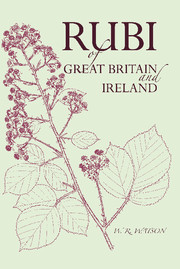Book contents
- Frontmatter
- Foreword
- Preface
- Contents
- INTRODUCTION
- I Environmental variations
- II Genetic intraspecific variations
- III Chromosomes and genes
- IV Reproduction
- V The species in Rubus
- VI Ecesis and migration
- VII Enemies, pests and diseases
- VIII Classification
- IX Collection and identification
- X Characteristics of the British-Irish bramble flora
- XI Cultivating native blackberries for fruit
- XII Note on the nomenclatural type species for the genus Rubus and subgenus Rubus
- XIII Key to the vice-county numbers
- XIV Signs and abbreviations
- ARRANGEMENT OF THE GENUS RUBUS LINN. IN AN ANALYTICAL KEY
- DESCRIPTIONS
- DRAWINGS
- Glossary
- Principal works consulted
- Index
III - Chromosomes and genes
Published online by Cambridge University Press: 05 June 2016
- Frontmatter
- Foreword
- Preface
- Contents
- INTRODUCTION
- I Environmental variations
- II Genetic intraspecific variations
- III Chromosomes and genes
- IV Reproduction
- V The species in Rubus
- VI Ecesis and migration
- VII Enemies, pests and diseases
- VIII Classification
- IX Collection and identification
- X Characteristics of the British-Irish bramble flora
- XI Cultivating native blackberries for fruit
- XII Note on the nomenclatural type species for the genus Rubus and subgenus Rubus
- XIII Key to the vice-county numbers
- XIV Signs and abbreviations
- ARRANGEMENT OF THE GENUS RUBUS LINN. IN AN ANALYTICAL KEY
- DESCRIPTIONS
- DRAWINGS
- Glossary
- Principal works consulted
- Index
Summary
Wherever known, the chromosome number is shown in the description. In some cases counts have been made only on one bush; the chromosome number is then starred. There is a possibility that a different number will be found when a second or third bush is examined in these cases, as where two bushes have been examined two different numbers have several times been obtained.
Certain results are, however, already sufficiently clear, namely (i) there is only one basic number, 7; (2) the chromosomes are found always in exact multiples of the basic number, with exceedingly rare exceptions; (3) the prevailing number is 28 in body cells, 14 in germ cells.
Three dwarf seedlings which appeared in a family raised from R. thyrsiger self-pollinated each had 27 chromosomes: it was claimed that they represented the systematists’ var. parvifolius. These dwarfs, however, proved to be comparatively infertile, whereas natural dwarfs are quite fertile. Moreover, several different natural dwarfs have now been studied and have been found to possess 28 chromosomes each. The implication, tfyen, based on the thyrsiger seedlings refers only to that case; the cause of the dwarfing in the other cases remains unexplained. It is also not known whether dwarfing is a reversible condition.
Different opinions prevail as to whether the forms of chromosomes can be distinguished well enough to throw light on the origin and relations of species in Rubus. In R. arcticus, idaeus, caesius, saxatilis, and hybrids artificially created between some of those species, the chromosomes have been studied, distinguished, delineated, and conclusions have been drawn from their form; their pairing behaviour in meiosis has also been established; but there is a difference of opinion between cytologists as to whether allotetraploidy or autotetraploidy is indicated in the parent species concerned, R. caesius and R. saxatilis. No doubt in course of time the doubt will be resolved to the satisfaction of cytologists. From a morphological point of view it seems very probable that R. caesius and R. saxatilis are of hybrid origin, and that one parent in each case is R. idaeus
- Type
- Chapter
- Information
- Publisher: Cambridge University PressPrint publication year: 2013



